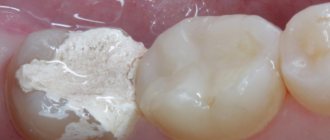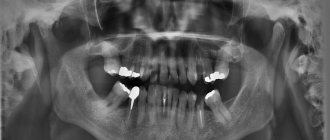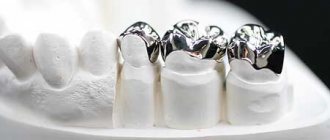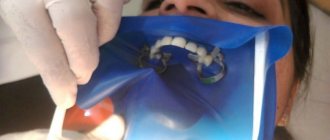Depophoresis is a method of disinfection of damaged internal tooth tissues with copper-calcium hydroxide, which increases the chances of saving complex teeth tenfold. The method is effective for narrow, winding roots. It is also suitable for re-treatment of poorly sealed canals, which cannot be completely unsealed.
Simply put, the procedure destroys pathogenic bacteria in hard-to-reach areas that cannot be treated with conventional instruments during surgical endodontic treatment.
Operating principle
Depophoresis is based on the ability of copper-calcium hydroxide to neutralize pathogenic microflora that has affected the pulp - the neurovascular bundle. Once in the canals, the substance penetrates into the farthest areas and sterilizes them. The process of proteolysis is activated: the “dead” pulp decomposes over time, and the disintegrated tissues are resorbed.
In addition to its disinfectant properties, copper-calcium hydroxide is also believed to stimulate bone formation. It is able to create an alkaline environment in which inflammatory processes cease and conditions for normal bone regeneration are created.
To ensure better passage of the substance through the channels, devices are used that deliver weak current discharges to the tooth. Under the influence of current, copper-calcium hydroxide ions move faster, their trajectory expands, and they spread along the channel.
Obturation using the Thermofil system
“Thermophile” is a titanium, plastic or steel cone-shaped rod coated with gutta-percha, which is in the alpha phase state. This coating is characterized by a lower melting point, increased fluidity and the ability to penetrate into the microtubules of the root passage. When introducing thermophile into the root canal, the base rod fills the main space, and gutta-percha fills only a small part of it. This is what makes it possible to solve the problem of significant shrinkage of the thermoplastic gutta-percha filler after cooling and to prevent the formation of microspaces between the walls of the root passage and the filler.
The procedure for sealing root passages, which involves the use of the Thermofil system, consists of the following stages:
- selection of suitable thermophile diameter;
- antiseptic treatment of the rod and its heating;
- introduction of sealant into the root canal;
- inserting the rod into the root canal until it stops;
- removal of excess gutta-percha from the dental cavity;
- restoration of a damaged tooth crown.
The use of the described technique allows for effective obturation of the main canal and its branches.
Scope of application in dentistry
The author of the method, German professor Adolf Knappvost, proposed depophoresis as an alternative to traditional endodontic treatment. According to his research, a positive result from disinfection of canals with copper-calcium hydroxide was observed in 95% of all cases.
However, domestic studies have shown that such high rates cannot be achieved. On the one hand, this difference in research results could be explained by the fact that domestic dentists used other devices instead of the equipment recommended by Knappvost.
On the other hand, living evidence that the method itself is not a universal panacea and does not always work, still speaks for itself. And you can't dispute them.
Yes, this method is undoubtedly effective. But only in combination with classical endodontic measures. For example, the canals are widened with endodontic instruments as far as possible, and then the areas that cannot be penetrated by the instrument are treated with copper-calcium hydroxide.
Depophoresis: indications and contraindications for the procedure
Depophoresis can and should be performed after each depulpation (nerve removal). But this procedure is especially strongly recommended if:
- you have to deal with crooked and hard-to-reach channels, which are very difficult to clean using instrumental means;
- the channels are already sealed and it is not possible to unseal them;
- a cyst was found at the root apex;
- Remnants of dead or gangrenous tissue were found in the canal.
When removing a tooth root using the standard method, there is always a risk of losing a piece of an instrument – a pulp extractor – in the canal. In this case, depophoresis can also help. Having destroyed the organic compounds, it becomes easier to remove the metal piece of the tool. But even if this cannot be done for some reason, being in a sterile environment, the fragment will not cause harm and will not provoke inflammation.
Depophoresis is a harmless procedure, so it can be performed by absolutely everyone, with the exception of only a few categories of patients, namely:
- pregnant women;
- allergy sufferers to copper;
- people suffering from an acute form of periodontitis.
In addition, depophoresis will have to be abandoned if the tooth canal was previously closed with a silver pin.
Indications
The most important indication is the impossibility of carrying out full endodontic treatment due to too narrow and impassable canals or those whose course is not visible at all. Since it is not possible to “pass” the entire length of the canals with conventional instruments, doctors resort to depophoresis.
Instead of instrumental removal of the affected pulp, it is chemically sterilized with copper-calcium hydroxide.
It is also recommended for patients with previously poorly filled canals in case of re-inflammation of the pulp.
Prescribed for:
- pulpitis;
- chronic periodontitis;
- cyst in the area of the root apex;
- the presence of gangrenous contents and/or dead tissue in the root;
- enlargement of the apical foramen. Nutrients and minerals enter the tooth through this hole.
Not indicated for patients with an allergy to copper, acute periodontitis, or a silver pin in the root. Also not performed on pregnant women.
Tooth affected by pulpitis
Filling with hot gutta-percha
Sealing the root passages with heated gutta-percha can be done in several ways. The most common of them are:
- injection method (filling the channel with material heated to 200 degrees);
- method of vertical condensation (laying filling material into the canal, distributing it with instruments along the side canals, installing a softened pin on top of it);
- continuous wave method (introducing a basic central pin into the tooth using a heated instrument, placing side pins around it, completely sealing the canal).
Devices for depophoresis
The device directs weak current charges to the problem tooth and stimulates the spread of copper-calcium hydroxide through the canal.
Adolf Knappvost exclusively used the Original II, manufactured by Humanchemie. This equipment is the only one approved for working according to the original method of Adolf Knappvost.
However, the alternatives are:
- "EndoEst" is also used for electroodontodiagnostics, electrophoresis, narrowing of the apical foramen, etc.;
- AOK 1.0 Modis – portable device with a graphic indicator;
- AOK 1.1 Endo-lux – equipment for electrophoresis, used as an alternative to Original II Humanchemie;
- AOK 2.1 is a compact device for depophoresis and various physiotherapeutic procedures.
Devices for depophoresis
Restrictions
There are not many contraindications to dipophoresis. Among them:
- pregnancy;
- acute periodonitis;
- a silver pin installed in the tooth;
- sensitivity to copper alloys.
Stages of the procedure
Before prescribing depophoresis, the doctor assesses the condition of the tooth roots based on an X-ray image. Manual pulp extraction is also performed.
Following actions:
- administration of appropriate anesthesia (taking into account clinical circumstances);
- insertion of a cathode electrode into the dental canal connected to the minus pole on the device (to a depth of 5-8 mm). The positive electrode of the device is localized from the inner surface of the cheek, without touching the teeth;
- Together with the supply of the solution to the channel (copper hydroxide containing calcium is used), an electric field is formed to ensure the movement of ions (current strength is 2 mA). The duration ranges from 5-10 minutes;
- the movement of ions facilitates their passage into all root tubules, ensuring thorough disinfection;
- at the end of the procedure, both electrodes are removed from the oral cavity, and the dental canal is thoroughly washed with 10% calcium hydroxide or distilled water;
- To fill the dental cavity, the same chemical reagent is used, but in the consistency of a paste.
The final filling of the tooth is carried out after two sessions. The interval between them is one to two weeks. As a rule, a repeat procedure is scheduled after 7 days. The course of treatment with depophoresis lasts about a month.
Equipment
The creator of the method, Porofessor Knappvost, guarantees the high efficiency of the technique only if the hardware developed by the German manufacturer Humanchemie (Original II) is used. As for the use of analogues of this device, their effectiveness has not been confirmed.
The German device is the development of the author of the technique himself. With its help, you can accurately calculate the dosage of electric current, as well as adjust the duration of the procedure.
Precautionary measures
- When using the device for depophoresis, it is important to monitor the condition of the mucous membrane of the lips in the area of influence of the electrode. This is necessary in order to prevent overheating of the tissues.
- Direct contact of the electrode and metal crowns in the oral cavity is not allowed.
The Humanchemie kit includes tools for implementing the procedure at various stages:
- to coat the dental nerve, a highly dispersed fraction of calcium hydroxide (in the form of a paste), as well as Kupral (copper calcium hydroxide), are used;
- methylcellulose - used for intermediate root insulation;
- distilled water - needed for flushing channels;
- during treatment and final filling, alkaline cement with a high percentage of copper, called Atatsamita, is used;
The kit also includes a special solution for curing it.
Description of the procedure
The pulp must first be devitalized, that is, it must stop performing all its functions, including the function of transmitting nerve impulses in response to pain.
Three sessions are required:
- In the first session, the doctor widens the root canal, fills it with copper-calcium hydroxide to a third or two-thirds of its depth and places electrodes in the patient's mouth.
- Then the depophoresis device is turned on, delivering a weak current discharge to the problem tooth. The process ends with the installation of a temporary filling.
- After 8-14 days, at the second session, the procedure is repeated. This is the optimal interval at which the risk of irritation from the application of current is zeroed out.
- At the last third session, the root is filled with atacamite, a special alkaline cement, and the canal is “closed” with a permanent filling.
Nuances of the treatment process
The procedure is minimally invasive, patients do not feel pain. There may only be unpleasant sensations from the application of current.
When working in the frontal area, after each session the oral cavity is thoroughly washed with highly dispersed copper-calcium hydroxide. This is necessary to prevent staining of the enamel.
The result of therapy can be known no earlier than six months later. As a rule, the results are positive and allow you to extend the life of “dead” teeth. After therapy, all patients must be in a dispensary group and regularly observed by a dentist.
Scheme of depopheresis
Canal filling using E&Q Plus
This is a sealing of the dental canal with hot gutta-percha, which includes an injection gun with a special heating tip and a control unit. The equipment included in the system allows you to use three filling techniques at once:
- vertical compaction of preheated material;
- gutta-percha injection;
- a combination of the above techniques.
The standard procedure for filling root passages using this system includes the following steps:
- introduction of a sealer into the canal and application of a gutta-percha pin;
- condensation of the pin in the apical direction using a hot electric plugger;
- cutting off the coronal part of the gutta-percha pin;
- filling the root canal with heated gutta-percha using a special obturator-gun;
- Compacting gutta-percha using a cold plugger system.
There are other methods of sealing root canals, but they are used much less frequently than those described above. One way or another, a competent approach to this procedure allows you to quickly and painlessly fill the root canals, returning the teeth not only to their original functionality, but also to their aesthetic properties.
Advantages
- Suitable for patients who cannot clean the canals in the traditional way: due to obstruction of the canals, as a result of dentist mistakes;
- sterilization ensures minimal risks of re-infection;
- high percentage of positive results. From 60-70 to 95% according to various studies;
- speed, simplicity and painlessness;
- allows you to avoid resection of the root apex in chronic periodontitis.
Below is a list of dentists that successfully practice complex root canal treatment using depophoresis.
Filling with chilled gutta-percha
Gutta-percha is a resinous compound obtained from the milky sap of a number of plants and is a high-molecular hydrocarbon similar in composition to natural rubber. There are several methods for sealing root passages using this material:
- single pin technique (the treated root course will have a shape identical to the shape of the pin, after which the gutta-percha pin is placed in the prepared hole);
- lateral condensation technique (initially the base pin is inserted into the center of the stroke, then the side ones);
- sealing using a rotating capacitor;
- filling with gutta-percha softened with chemicals.
What are the risks and possible complications?
Before going for depophoresis, it is important to find out all the nuances and features of the effects of copper hydroxide, including negative ones. So, for example, prolonged contact of this substance with dentin leads to weakening of the latter, and this occurs due to the gradual dissolution of collagen. Therefore, this method is rarely used for the frontal group of teeth due to the risk of staining them.
This method is not used for front teeth due to the risk of darkening them.
The modern technique is recognized as completely safe, of course, provided the doctor strictly adheres to the technology of the procedure and the patient has no contraindications. Copper has a toxic effect on the body, however, within the framework of its use in dentistry, any risks of complications are reduced to virtually zero. If depophoresis is carried out carelessly, inflammatory reactions are possible.
“I treated the root of one tooth for a long time, went to the dentist several times for treatment and root canal treatment. And just the other day, the doctor gave me depophoresis for the first time. Personally, I was immediately warned about a possible exacerbation. At first I felt some discomfort in the gums, and the next morning I discovered a slight gumboil. Again I had to go to the doctor to open the abscess. I’m tired of this tooth, I’ll probably have to remove it.”
Katya79, Ekaterinburg, from correspondence on the woman.ru forum
Prevention of complications
Depophoresis has no side effects. However, the patient must follow a number of rules to avoid the recurrence of pulpitis:
- do not violate the schedule of visits to the dentist,
- undergo preventive examinations once every six months,
- monitor oral hygiene - use high-quality toothpaste, a brush of suitable hardness, rinses, floss.
To prevent pulpitis, caries must be treated in a timely manner. If carious lesions appear, do not delay your visit to the clinic.
Depophoresis - a method of root canal treatment and features of its application
In dentistry, depophoresis is a technique for disinfecting the internal structures of a tooth, which can greatly increase the chances of saving it. This method is used mainly for teeth with a tortuous root system, and its essence lies in the effect of copper-calcium hydroxide on the affected tissue. This option for root canal treatment allows you to kill bacteria even in hard-to-reach places that cannot be properly cleaned by other methods. Read more about this procedure further in this article.











